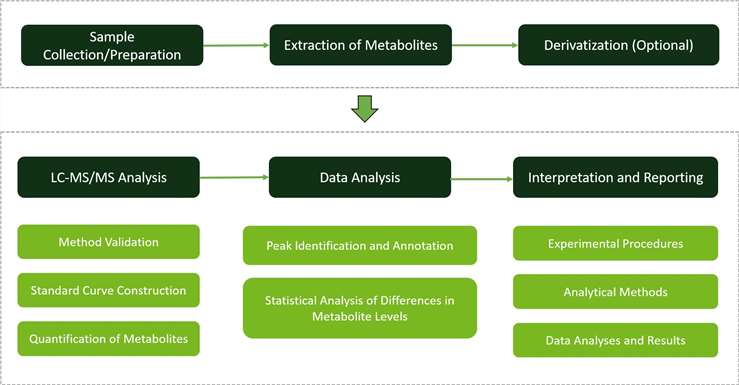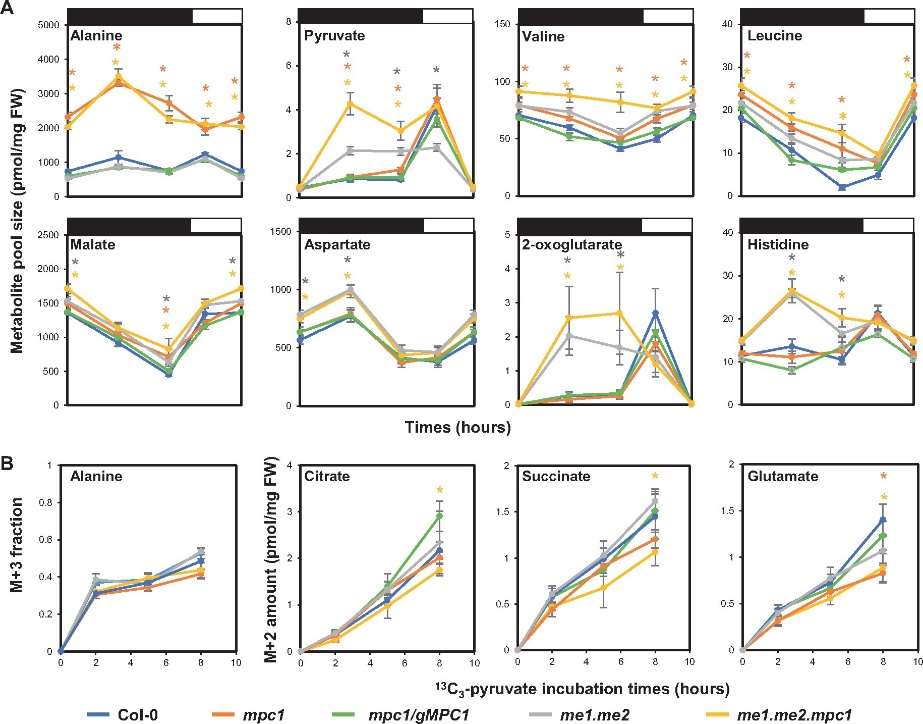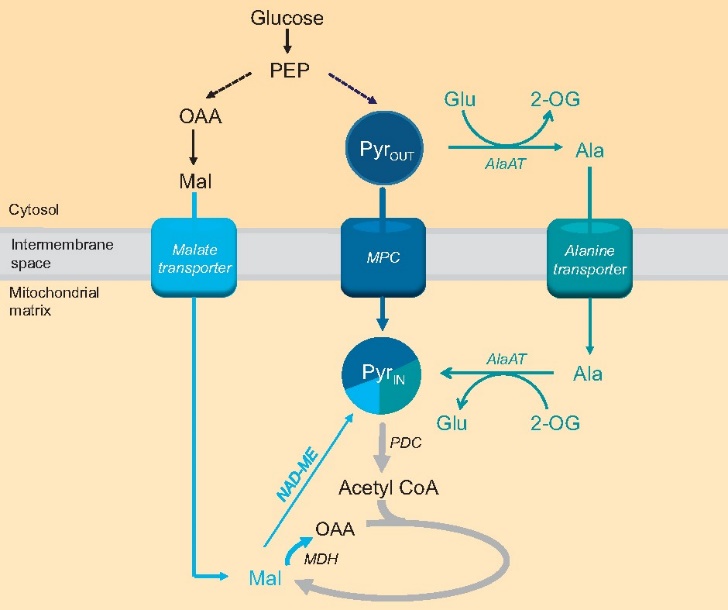What is Alanine Metabolism?
Alanine, a non-essential amino acid, plays a crucial role in energy metabolism and the tricarboxylic acid cycle (TCA) within plants. It actively engages in metabolic processes to produce ATP, fulfilling the energy requirements essential for plant growth and development. Moreover, alanine facilitates photosynthesis and the acquisition of chlorophyll, thereby fostering greener foliage and heightened metabolic activity in plants.
Alanine metabolism in plants encompasses the synthesis, utilization, and degradation of alanine, which plays pivotal roles in nitrogen transport, cell wall structure, and stress responses such as drought and hypoxia. Creative Proteomics's alanine metabolism analysis service is tailored to unravel these intricate processes, providing comprehensive insights into alanine dynamics within plant systems.
Alanine Metabolism Analysis Service by Creative Proteomics
Alanine Metabolism Metabolite Profiling
Creative Proteomics offers advanced metabolite profiling techniques to comprehensively characterize the metabolites involved in alanine metabolism. This profiling provides a detailed understanding of the metabolic landscape in plant systems, facilitating targeted interventions for enhanced agricultural productivity and stress resilience.
Alanine Metabolism Enzyme Activity Assessment
Our service investigates the synthesis, utilization, and degradation of alanine in plants. By analyzing key intermediates and regulatory enzymes, we uncover the mechanisms driving plant metabolism.
Alanine Metabolism Correlation Analysis
Our correlation analysis service integrates metabolomics data with transcriptomics and proteomics datasets. By correlating metabolite levels with gene expression and enzyme activity profiles, we identify key regulatory mechanisms governing alanine metabolism and its interconnected pathways.
Techniques and Instrumentation for Alanine Metabolism Analysis
Liquid Chromatography (LC): The LC platform at Creative Proteomics employs a dual-column, four-needle injection mode, enhancing detection efficacy. By incorporating an Amide chromatography gradient, the system significantly improves the separation conditions for polar substances like amino acids.
Mass Spectrometry (MS): Mass spectrometry (MS) is the cornerstone of our alanine metabolism analysis at Creative Proteomics. We utilize Liquid Chromatography-Mass Spectrometry (LC/MS) to ensure comprehensive and accurate analysis. It enables the quantification of low-concentration and complex samples with unparalleled accuracy. The sensitivity and specificity of MS make it ideal for detecting even minute quantities of alanine and its metabolites.
LC-MS/MS Method Establishment and Optimization: We establish precise quantification methods using reference standards to ensure accurate determination of arginine and related compounds. Multiple Reaction Monitoring (MRM)/Selected Reaction Monitoring (SRM) enhances the analysis and quantification of amino acids and peptides. Its capability to handle complex mixtures and provide detailed ion information makes it a key technique in alanine metabolism analysis.

Why Choose Us?
- Precision and Accuracy: We utilize state-of-the-art mass spectrometry and stringent quality control to ensure highly dependable results in alanine metabolism analysis.
- Stability and Reproducibility: Our standardized workflows and protocols guarantee consistent outcomes across large sample volumes.
- Comprehensive Data Analysis: We offer extensive data analysis options tailored to alanine metabolism, integrating with a robust plant metabolomics cloud platform for in-depth bioinformatics exploration.
- Tailored Solutions: We provide customized reports and expert consultations to meet specific research needs.
- Cost-Effective Services: We offer competitive pricing, making advanced alanine metabolism analysis accessible to a wide range of clients.
- Comprehensive Support: Our team offers pre- and post-analysis consultations, assisting with result interpretation, troubleshooting, and facilitating research progress from start to publication.
Applications of Alanine Metabolism Analysis
Investigation of Biological Energy Metabolism: Alanine participates in plant energy metabolism and the tricarboxylic acid (TCA) cycle, providing energy for plant growth. Quantitative analysis of alanine's role in plant energy metabolism elucidates its critical involvement in the TCA cycle, providing vital data support for studying plant energy metabolism.
Research on Plant Defense Mechanisms: Alanine exhibits resistance against pathogens. Exploration of alanine's role in combating pathogenic bacteria in plants helps uncover its potential role in plant disease resistance mechanisms, providing a theoretical basis for disease-resistant crop breeding.
Study of Plant Growth Regulation: Alanine is associated with aiding photosynthesis and chlorophyll acquisition. Its application promotes greener plants and enhances metabolic activity. Analysis of the variations of alanine in plant growth and development elucidates its relationship with plant growth regulation, offering insights for optimizing plant growth regulation strategies.
Sample Requirements for Alanine Metabolism Assay
| Sample Type |
Sample Volume |
Notes |
| Blood (Serum/Plasma) |
0.5 - 2 mL |
Collect in a fasting state if possible. Use EDTA or heparin tubes. |
| Urine |
10 - 50 mL |
First morning urine sample preferred. Collect in a sterile container. |
| Tissue Samples |
50 - 100 mg |
Fresh or frozen tissue. Ensure rapid freezing post-collection to -80°C. |
| Cell Culture |
1 - 5 x 10^6 cells |
Harvest cells and wash with PBS. Lyse cells for analysis. |
| Cerebrospinal Fluid (CSF) |
0.2 - 1 mL |
Collect via lumbar puncture, ensure sterility. |
| Saliva |
1 - 2 mL |
Collect unstimulated saliva in sterile tubes. |
| Feces |
5 - 10 g |
Collect in a sterile container. Ensure immediate processing or freezing. |
| Plant Leaves |
100 - 500 mg |
Collect fresh leaves, freeze immediately in liquid nitrogen. |
| Plant Roots |
100 - 500 mg |
Collect fresh roots, clean thoroughly, and freeze immediately. |
| Plant Seeds |
50 - 200 mg |
Collect mature seeds, store in a cool, dry place, or freeze. |
| Plant Stems |
100 - 500 mg |
Collect fresh stems, freeze immediately in liquid nitrogen. |
Each experimental treatment should have more than 6 biological replicates to ensure robust statistical analysis and reliable interpretation of results.
For other sample types not listed above, such as flowers or whole plants, please consult our technical support or sales team for specific requirements and recommendations.
Case. The Crucial Role of Alanine in Compensating for Pyruvate Transport Deficiency in Arabidopsis Mitochondria
Background:
The study investigates the role of the mitochondrial pyruvate carrier (MPC) in Arabidopsis thaliana. Pyruvate is essential for mitochondrial respiration and the TCA cycle, but its transport into mitochondria in plants is not well understood.
This research demonstrates MPC1's critical role in pyruvate import and the synergistic function of pyruvate-supplying pathways in plant metabolism.
Samples:
Arabidopsis thaliana mutants used include MPC1 T-DNA insertion line SALK008945 and previously characterized me1.me2 seeds. Crosses were performed to generate me1.me2.mpc1 mutants.
Complemented lines were generated by introducing genomic MPC1 with its endogenous promoter into mutants via Agrobacterium-mediated transformation.
Plants were grown under long-day (16-h light/8-h dark) or short-day (8-h light/16-h dark) conditions with specific conditions for cycloserine treatments and metabolic analyses.
Technical methods procedure:
RNA extraction and quantitative PCR were performed to analyze gene expression.
Arabidopsis seedlings were grown in liquid media and mitochondria were isolated from 2-week-old seedlings. Oxygen consumption rate (OCR) was measured in varying concentrations of pyruvate and malate. Enzyme activities of PDH and NAD-ME were assayed as described previously.
Leaf discs were collected from 6-week-old plants and metabolites were extracted using methanol. Organic acids and amino acids were quantified using a HPLC system coupled to a triple quadrupole mass spectrometer, with specific chromatographic conditions for each analysis.
Isolated mitochondria were incubated with pyruvate, malate, cofactors, and ADP. Metabolite extraction and analysis were performed using LC–SRM–MS. Leaf discs were incubated with 13C-labeled pyruvate or glucose and metabolites were analyzed using HPLC–TOF–MS.
Mitochondrial proteins were precipitated, trypsin-digested, and analyzed using LC–SRM–MS. Peptide abundances were normalized against voltage-dependent anion channel (VDAC).
Two-sided t-tests were used for statistical analyses with details provided in figure legends. Biological replicates were collected from different plant batches or plants grown simultaneously.
Results
MPC1 is crucial for the accumulation of the mitochondrial pyruvate carrier complex in Arabidopsis, with its absence leading to the concurrent loss of MPC3 and MPC4.
The absence of MPC1 in mitochondria prevents the uptake of pyruvate into the matrix, significantly reducing the production of TCA cycle intermediates.
The mitochondrial NAD-dependent malic enzyme pathway compensates for the lack of MPC1 by converting malate into pyruvate, maintaining pyruvate supply for mitochondrial metabolism.
Alanine transamination provides an alternative pyruvate source, sustaining mitochondrial TCA cycle metabolism and respiration in the absence of both MPC1 and NAD-ME.
Plants deficient in both MPC1 and NAD-ME exhibit heightened sensitivity to the alanine aminotransferase inhibitor cycloserine, highlighting the significance of alanine in maintaining pyruvate levels for mitochondrial function.
 Fig 1. Alanine accumulation and usage helps supply pyruvate in the absence of MPC and NAD-ME. (A) Diurnal changes of representative metabolites. (B) Time courses of 13C-labelling into metabolites using 13C3-pyruvate in darkened leaf discs.
Fig 1. Alanine accumulation and usage helps supply pyruvate in the absence of MPC and NAD-ME. (A) Diurnal changes of representative metabolites. (B) Time courses of 13C-labelling into metabolites using 13C3-pyruvate in darkened leaf discs.
 Fig 2. The mitochondrial pyruvate pool is contributed to by multiple supply pathways. A combination of in vitro, in organello, and in vivo analyses suggest the supply of mitochondrial pyruvate is facilitated mainly by MPC and AlaAT pathways; inhibition of one is compensated for by the other . Dashed lines indicate unknown relative fluxes. Bolder arrows indicate larger flux compared to other pathways usingor generating the same metabolite. PEP, phosphoenolpyruvate; Pyrout, pyruvate in the cytosol, Pyrin, pyruvate inside the mitochondrial matrix; Ala, alanine; Glu, glutamate.
Fig 2. The mitochondrial pyruvate pool is contributed to by multiple supply pathways. A combination of in vitro, in organello, and in vivo analyses suggest the supply of mitochondrial pyruvate is facilitated mainly by MPC and AlaAT pathways; inhibition of one is compensated for by the other . Dashed lines indicate unknown relative fluxes. Bolder arrows indicate larger flux compared to other pathways usingor generating the same metabolite. PEP, phosphoenolpyruvate; Pyrout, pyruvate in the cytosol, Pyrin, pyruvate inside the mitochondrial matrix; Ala, alanine; Glu, glutamate.
Reference
- Le, X. H. (2021). "The mitochondrial pyruvate carrier (MPC) complex mediates one of three pyruvate-supplying pathways that sustain Arabidopsis respiratory metabolism." The Plant Cell 33(8), 2776-2793.



 Fig 1. Alanine accumulation and usage helps supply pyruvate in the absence of MPC and NAD-ME. (A) Diurnal changes of representative metabolites. (B) Time courses of 13C-labelling into metabolites using 13C3-pyruvate in darkened leaf discs.
Fig 1. Alanine accumulation and usage helps supply pyruvate in the absence of MPC and NAD-ME. (A) Diurnal changes of representative metabolites. (B) Time courses of 13C-labelling into metabolites using 13C3-pyruvate in darkened leaf discs. Fig 2. The mitochondrial pyruvate pool is contributed to by multiple supply pathways. A combination of in vitro, in organello, and in vivo analyses suggest the supply of mitochondrial pyruvate is facilitated mainly by MPC and AlaAT pathways; inhibition of one is compensated for by the other . Dashed lines indicate unknown relative fluxes. Bolder arrows indicate larger flux compared to other pathways usingor generating the same metabolite. PEP, phosphoenolpyruvate; Pyrout, pyruvate in the cytosol, Pyrin, pyruvate inside the mitochondrial matrix; Ala, alanine; Glu, glutamate.
Fig 2. The mitochondrial pyruvate pool is contributed to by multiple supply pathways. A combination of in vitro, in organello, and in vivo analyses suggest the supply of mitochondrial pyruvate is facilitated mainly by MPC and AlaAT pathways; inhibition of one is compensated for by the other . Dashed lines indicate unknown relative fluxes. Bolder arrows indicate larger flux compared to other pathways usingor generating the same metabolite. PEP, phosphoenolpyruvate; Pyrout, pyruvate in the cytosol, Pyrin, pyruvate inside the mitochondrial matrix; Ala, alanine; Glu, glutamate.

